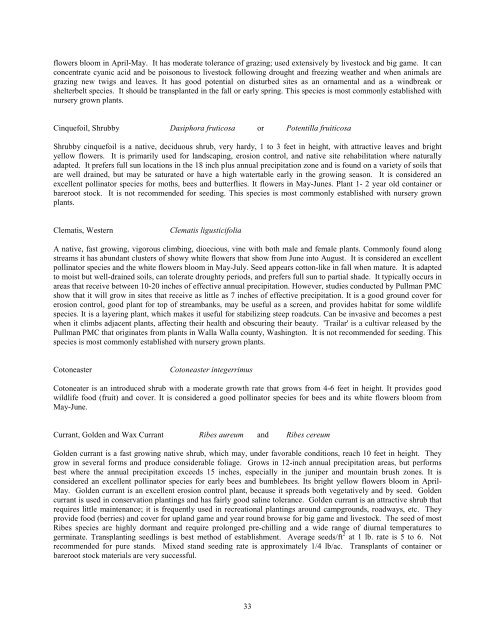Idaho Plant Materials Technical Note No. 24
Idaho Plant Materials Technical Note No. 24
Idaho Plant Materials Technical Note No. 24
Create successful ePaper yourself
Turn your PDF publications into a flip-book with our unique Google optimized e-Paper software.
flowers bloom in April-May. It has moderate tolerance of grazing; used extensively by livestock and big game. It can<br />
concentrate cyanic acid and be poisonous to livestock following drought and freezing weather and when animals are<br />
grazing new twigs and leaves. It has good potential on disturbed sites as an ornamental and as a windbreak or<br />
shelterbelt species. It should be transplanted in the fall or early spring. This species is most commonly established with<br />
nursery grown plants.<br />
Cinquefoil, Shrubby Dasiphora fruticosa or Potentilla fruiticosa<br />
Shrubby cinquefoil is a native, deciduous shrub, very hardy, 1 to 3 feet in height, with attractive leaves and bright<br />
yellow flowers. It is primarily used for landscaping, erosion control, and native site rehabilitation where naturally<br />
adapted. It prefers full sun locations in the 18 inch plus annual precipitation zone and is found on a variety of soils that<br />
are well drained, but may be saturated or have a high watertable early in the growing season. It is considered an<br />
excellent pollinator species for moths, bees and butterflies. It flowers in May-Junes. <strong>Plant</strong> 1- 2 year old container or<br />
bareroot stock. It is not recommended for seeding. This species is most commonly established with nursery grown<br />
plants.<br />
Clematis, Western<br />
Clematis ligusticifolia<br />
A native, fast growing, vigorous climbing, dioecious, vine with both male and female plants. Commonly found along<br />
streams it has abundant clusters of showy white flowers that show from June into August. It is considered an excellent<br />
pollinator species and the white flowers bloom in May-July. Seed appears cotton-like in fall when mature. It is adapted<br />
to moist but well-drained soils, can tolerate droughty periods, and prefers full sun to partial shade. It typically occurs in<br />
areas that receive between 10-20 inches of effective annual precipitation. However, studies conducted by Pullman PMC<br />
show that it will grow in sites that receive as little as 7 inches of effective precipitation. It is a good ground cover for<br />
erosion control, good plant for top of streambanks, may be useful as a screen, and provides habitat for some wildlife<br />
species. It is a layering plant, which makes it useful for stabilizing steep roadcuts. Can be invasive and becomes a pest<br />
when it climbs adjacent plants, affecting their health and obscuring their beauty. 'Trailar' is a cultivar released by the<br />
Pullman PMC that originates from plants in Walla Walla county, Washington. It is not recommended for seeding. This<br />
species is most commonly established with nursery grown plants.<br />
Cotoneaster<br />
Cotoneaster integerrimus<br />
Cotoneater is an introduced shrub with a moderate growth rate that grows from 4-6 feet in height. It provides good<br />
wildlife food (fruit) and cover. It is considered a good pollinator species for bees and its white flowers bloom from<br />
May-June.<br />
Currant, Golden and Wax Currant Ribes aureum and Ribes cereum<br />
Golden currant is a fast growing native shrub, which may, under favorable conditions, reach 10 feet in height. They<br />
grow in several forms and produce considerable foliage. Grows in 12-inch annual precipitation areas, but performs<br />
best where the annual precipitation exceeds 15 inches, especially in the juniper and mountain brush zones. It is<br />
considered an excellent pollinator species for early bees and bumblebees. Its bright yellow flowers bloom in April-<br />
May. Golden currant is an excellent erosion control plant, because it spreads both vegetatively and by seed. Golden<br />
currant is used in conservation plantings and has fairly good saline tolerance. Golden currant is an attractive shrub that<br />
requires little maintenance; it is frequently used in recreational plantings around campgrounds, roadways, etc. They<br />
provide food (berries) and cover for upland game and year round browse for big game and livestock. The seed of most<br />
Ribes species are highly dormant and require prolonged pre-chilling and a wide range of diurnal temperatures to<br />
germinate. Transplanting seedlings is best method of establishment. Average seeds/ft 2 at 1 lb. rate is 5 to 6. <strong>No</strong>t<br />
recommended for pure stands. Mixed stand seeding rate is approximately 1/4 lb/ac. Transplants of container or<br />
bareroot stock materials are very successful.<br />
33
















